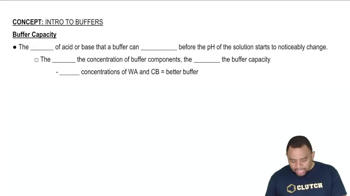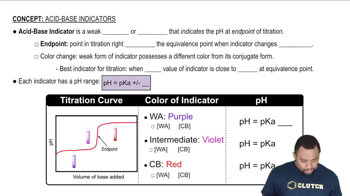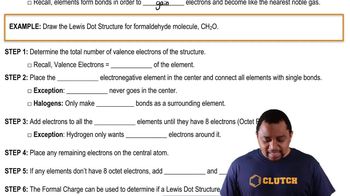Determine whether or not the mixing of each pair of solutions results in a buffer. a. 75.0 mL of 0.10 M HF; 55.0 mL of 0.15 M NaF b. 150.0 mL of 0.10 M HF; 135.0 mL of 0.175 M HCl d. 125.0 mL of 0.15 M CH3NH2; 120.0 mL of 0.25 M CH3NH3Cl
Ch.18 - Aqueous Ionic Equilibrium

Chapter 18, Problem 55c
Blood is buffered by carbonic acid and the bicarbonate ion. Normal blood plasma is 0.024 M in HCO3- and 0.0012 M H2CO3 (pKa1 for H2CO3 at body temperature is 6.1).
c. Given the volume from part (b), what mass of NaOH can be neutralized before the pH rises above 7.8?
 Verified step by step guidance
Verified step by step guidance1
1. The first step is to understand the concept of buffers. A buffer is a solution that can resist pH change upon the addition of an acidic or basic components. It is able to neutralize small amounts of added acid or base, thus maintaining the pH of the solution relatively stable. This is achieved by including a weak acid and its conjugate base (as in this case, H2CO3 and HCO3-).
2. The Henderson-Hasselbalch equation is used to calculate the pH of a buffer solution. The equation is: pH = pKa + log([A-]/[HA]), where [A-] is the molar concentration of the base (HCO3- in this case) and [HA] is the molar concentration of the acid (H2CO3 in this case).
3. To find the pH at which NaOH can be neutralized, we need to rearrange the Henderson-Hasselbalch equation to solve for [A-]/[HA]. This gives us: [A-]/[HA] = 10^(pH - pKa). We can then substitute the given pH (7.8) and pKa (6.1) into this equation to find the ratio of [A-] to [HA] at this pH.
4. Once we have the ratio of [A-] to [HA], we can use it to calculate the amount of NaOH that can be neutralized. This is because the addition of NaOH will consume H2CO3 and produce HCO3-, changing the ratio of [A-] to [HA]. We can set up an equation representing this reaction and solve for the amount of NaOH that can be added before the ratio of [A-] to [HA] reaches the value calculated in step 3.
5. Finally, once we have the amount of NaOH in moles, we can convert it to mass by multiplying by the molar mass of NaOH (approximately 40 g/mol). This will give us the mass of NaOH that can be neutralized before the pH rises above 7.8.

Verified video answer for a similar problem:
This video solution was recommended by our tutors as helpful for the problem above.
Video duration:
4mWas this helpful?
Key Concepts
Here are the essential concepts you must grasp in order to answer the question correctly.
Buffer Systems
Buffer systems are solutions that resist changes in pH upon the addition of small amounts of acids or bases. In blood, the carbonic acid (H2CO3) and bicarbonate ion (HCO3-) work together to maintain a stable pH, crucial for physiological functions. The equilibrium between these two components allows the blood to neutralize excess acids or bases, keeping the pH within a narrow range.
Recommended video:
Guided course

Buffer Capacity
pKa and Acid-Base Equilibrium
The pKa value is a measure of the strength of an acid in solution, indicating the pH at which half of the acid is dissociated. For carbonic acid, with a pKa of 6.1, this means that at pH 6.1, the concentrations of H2CO3 and HCO3- are equal. Understanding pKa is essential for predicting how the buffer system will respond to added acids or bases, such as NaOH in this case.
Recommended video:
Guided course

Acid-Base Indicators
Neutralization Reactions
Neutralization reactions occur when an acid reacts with a base to form water and a salt, effectively reducing the acidity or basicity of the solution. In this scenario, adding NaOH (a strong base) to the buffered solution will react with H2CO3, leading to the formation of HCO3- and water. Calculating the mass of NaOH that can be added before the pH exceeds 7.8 involves understanding the stoichiometry of the reaction and the buffer capacity.
Recommended video:
Guided course

Lewis Dot Structures: Neutral Compounds
Related Practice
Textbook Question
1
views
Textbook Question
Determine whether or not the mixing of each pair of solutions results in a buffer. c. 165.0 mL of 0.10 M HF; 135.0 mL of 0.050 M KOH
1
views
Textbook Question
Blood is buffered by carbonic acid and the bicarbonate ion. Normal blood plasma is 0.024 M in HCO3- and 0.0012 M H2CO3 (pKa1 for H2CO3 at body temperature is 6.1).
a. What is the pH of blood plasma?
Textbook Question
The fluids within cells are buffered by H2PO4- and HPO42- . b. Could a buffer system employing H3PO4 as the weak acid and H2PO4- as the weak base be used as a buffer system within cells? Explain.
1
views
Textbook Question
Which buffer system is the best choice to create a buffer with pH = 9.00? For the best system, calculate the ratio of the masses of the buffer components required to make the buffer. HF/KF HNO2/KNO2 NH3/NH4Cl HClO/KClO
